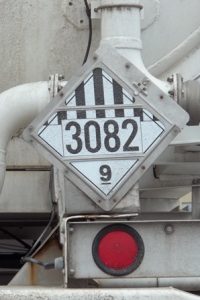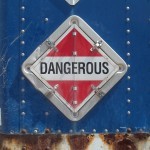May 20, 2015: A question from someone with whom I have not yet had the opportunity to do business. In other words, a HazMat Professional – not a customer – who needs help with a question:
Mr. Stoehr,
I was hoping you could answer a question that has been bugging me for a while.
Suppose a freight container, containing 900 pounds of Class 9 hazardous material and 200 pounds of another Table 2 Hazardous material – let’s say it is corrosive- is moving within the US. 49 CFR 172.504(c) makes placards optional* for a freight container with fewer than 1,001 pounds of Table 2 hazardous materials. Further 49 CFR 172.504(f)(9) exempts the showing of the Class 9 placard since the shipment is moving domestically.
I’ve only ever been able to interpret this as follows:
The shipment has 1,100 aggregate gross weight of Table 2 Hazardous Materials, so placards (Corrosive and Class 9) are required. Further the shipment is moving domestically so the Class 9 placard is not required. Therefore the corrosive placard is required.
However some shippers I interact with insist the corrosive placard is not required because the Class 9 hazardous material is exempted from placarding and the remaining hazardous materials are below the 1,001 lb threshold.
Do you know which interpretation is correct? Has a clarification to this issue ever been documented to your knowledge? Any help is appreciated.
P.S. I don’t need an answer to this, but… if my interpretation is correct, could a DANGEROUS placard be used instead of a corrosive placard?
*DTS Note: “Optional”? Read this article: Driver Option to Display Placards @ 49 CFR 172.502(c)
I knew this one was going to take some time, so I replied and let him know I would get back to him soon (4.20.15):
Thanks for the question. I will look into it and get back to you.
My reply on June 2, 2015:
Short answer: A shipper or carrier of HazMat is not required to include the weight of a Class 9 Miscellaneous for the purpose of determining the placarding exception at 49 CFR 172.504(c).
Example: 500 lbs Class 3 Flammable and 600 lbs Class 9 Miscellaneous (both in non-bulk packaging) = No placards required since the aggregate gross weight of HazMat counted toward the threshold is only 500 lbs.
The answer to ‘Why?’ is a little more complicated.
It’s initially confusing because Table 2 at 49 CFR 172.504(e) includes Class 9 Miscellaneous [with a reference to 49 CFR 172.504(f)(9)] and because 49 CFR 172.504(c) specifically includes the HazMat identified in Table 2 in its threshold determination, “…when hazardous materials covered by table 2 of this section are transported by highway or rail…” (emphasis mine). These two references to Class 9 Miscellaneous along with the other hazard class placards might lead one to think that it is included when determining if the exception at 49 CFR 172.504(c) applies to your mixed cargo of Class 9 Miscellaneous and other HazMat.
However, two regulatory citations – and an old letter of interpretation from PHMSA (09-007)* confirm my earlier ‘short answer’.
Regulation #1: 49 CFR 172.504(a) General, includes the following:
(a) Except as otherwise provided in this subchapter, each bulk packaging, freight container, unit load device, transport vehicle or rail car containing any quantity of a hazardous material must be placarded on each side and each end with the type of placards specified in tables 1 and 2 of this section and in accordance with other placarding requirements of this subpart,…(emphasis mine, again)
So, right off the bat the Part indicates that their might be exceptions to the rule as it initially appears in the regulations.
Regulation #2: 49 CFR 172.504(f)(9), which is referenced in Table 2, states that the Class 9 Miscellaneous placard is not required to be displayed within the U.S. This can be interpreted to mean that it is not counted towards placarding thresholds as well.
The trump card is the PHMSA Letter of Interpretation (09-007)* which clearly states in answer to this question:
Only materials that are covered by Table 2 and that require placarding are included in the aggregate gross weight. Although Class 9 is covered by Table 2, it does not require placarding.
(emphasis mine)
As to your P.S., the answer to that is ‘No’ as well. Given the above is correct, and pursuant to 49 CFR 172.504(b), the Dangerous placard can only be used when two or more hazardous materials that require placarding are present (and, of course, other conditions of using the Dangerous placard are met. For example: When not to use the Dangerous Placard).
I hope this helps.
Please don’t hesitate to contact me with any other questions.
*DTS Note: This letter of interpretation from PHMSA/USDOT is valid though, due to its age, it no longer appears on their on-line database. Perhaps it’s time for someone to request another letter of interpretation on this topic in order to refresh the database?
|
Contact me with any questions you may have about the transportation of hazardous materials by air, highway, vessel, or rail International and Domestic Daniels Training Services 815.821.1550 |
These kinds of questions come up all the time regarding the transportation of hazardous materials. And, as you can see, their are as many differences of opinion on the answer as their are questions. If you can’t find the answers to your questions, then by all means contact me. I’m more than happy to assist you with your question about HazMat transportation.

